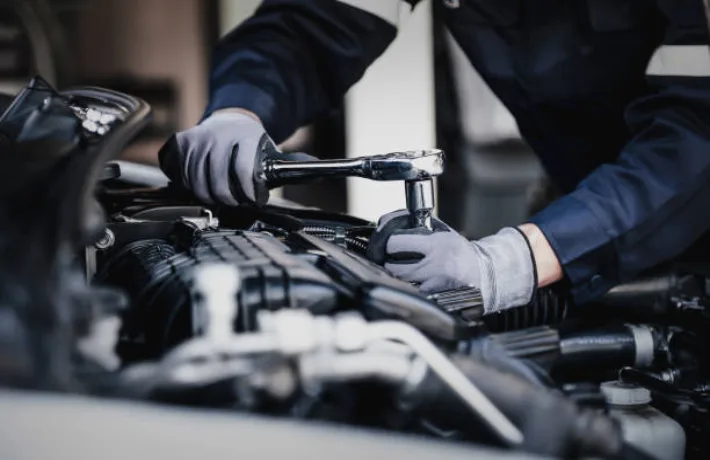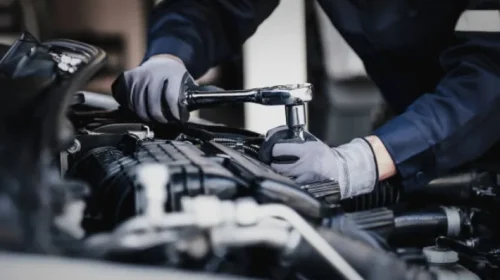Automotive engineering is an intricate field; understanding a car’s fundamental parts is essential for enthusiasts and everyday drivers. Each component, from the powerhouse engine to the safety-critical brakes, plays a vital role in ensuring a vehicle’s smooth operation and performance.
Important used auto parts include the engine, battery, brakes, and radiator. Understanding these components is vital for efficient vehicle operation and upkeep. Familiarize yourself with these key parts to enhance your knowledge of your car’s functioning and maintenance needs.
In this comprehensive guide, we explore a car’s ten major parts, functions, importance, and maintenance. Familiarize yourself with these key parts to enhance your knowledge of your car’s functioning and maintenance needs.
What are the Important Parts of a Car | 10 Components
The following are the most important parts of a car:
Engine
At the core of a vehicle’s functionality lies the engine that propels the car forward with power and efficiency. The engine is the powerhouse, converting energy into motion to drive the wheels and facilitate movement.
Whether powered by internal combustion or electric motors, the engine’s performance is vital for the vehicle’s operation. Regular maintenance, such as oil changes and tuning, ensures the engine operates smoothly and efficiently.
Components like the cylinders, pistons, crankshaft, and camshaft play crucial roles in the engine’s function, working harmoniously to generate power for the vehicle. Understanding these components and their functions is key to maintaining a well-functioning engine.
Battery
The battery, a critical component in a car’s electrical system, plays a pivotal role in providing the initial spark to start the vehicle and powering various electrical systems within the vehicle. Regular inspection and timely replacement every 5-6 years are crucial for uninterrupted functionality, preventing unexpected breakdowns and electrical issues.
The battery stores electrical energy that’s used to start the engine, operate lights, power windows, and many other electrical components in the car. It’s essential to ensure that the battery terminals are clean and free from corrosion to maintain a strong connection. A weak battery can lead to starting problems and can even cause damage to the vehicle’s electrical system if not addressed promptly.
Brakes
Inspecting the brake system regularly is imperative for ensuring safe and efficient vehicle operation on the road. Brakes play a crucial role in vehicle safety, whether they’re disc or drum systems. These components are responsible for slowing down and stopping the car, making their proper function essential.
Any unusual noises, vibrations, or signs of wear shouldn’t be overlooked, as they could indicate potential issues with the brakes. Prompt inspection and, if necessary, replacement of brake components are critical to maintaining optimal braking performance.
Regular maintenance, such as checking brake pads, rotors, calipers, and brake fluid levels, can help prevent brake failure and ensure a safe driving experience.
Radiator
Playing a crucial role in the cooling system, the radiator efficiently dissipates heat through liquid coolant to prevent engine overheating. As hot coolant flows from the engine to the radiator, it releases heat to the surrounding air through the radiator fins. This process lowers the temperature of the coolant, which then returns to the engine to absorb more heat.
It’s essential to regularly check coolant levels and the radiator’s condition to ensure optimal cooling efficiency. A well-functioning radiator is vital for maintaining the engine at a safe operating temperature and preventing damage due to overheating. Proper maintenance of the radiator system contributes to the longevity and performance of your vehicle’s engine.
Transmission
Responsible for facilitating power transfer from the engine to the wheels, the transmission system is a critical component in ensuring the movement of a vehicle.
The transmission consists of various parts such as gears, shafts, and clutches that work together to engage and disengage power flow. In a manual transmission, the driver must shift gears using a clutch pedal, while in an automatic transmission, the system shifts gears automatically based on speed and load.
Regular maintenance, including checking fluid levels, inspecting for leaks, and ensuring proper gear operation, is crucial for the longevity and performance of the transmission.
Neglecting maintenance can lead to issues like rough shifting, slippage, or even complete transmission failure.
Shock Absorbers
Shock absorbers, essential components of a vehicle’s suspension system, play a crucial role in stabilizing the car and ensuring a smooth driving experience by maintaining optimal tire contact with the road surface.
These components work by absorbing and dampening the shocks and vibrations generated as the vehicle moves over uneven terrain or encounters bumps on the road. By doing so, shock absorbers help prevent excessive bouncing, swaying, or nose-diving, which can compromise vehicle stability and control.
Regular inspection and timely replacement of worn-out shock absorbers are essential to maintain ride comfort, handling, and overall safety. Keeping these components in good condition contributes significantly to the vehicle’s performance and the driver’s comfort on the road.
Catalytic Converter
The catalytic converter, a vital component of a vehicle’s emissions control system, plays a crucial role in reducing harmful pollutants before they’re released into the environment. By converting toxic gases like carbon monoxide, nitrogen oxides, and hydrocarbons into less harmful emissions such as carbon dioxide, nitrogen, and water vapor, catalytic converters help minimize the environmental impact of vehicles.
These devices contain precious metals like platinum, palladium, and rhodium, which act as catalysts to facilitate chemical reactions that transform harmful pollutants into more benign substances. While catalytic converters are durable and typically don’t require frequent replacement, ensuring they’re functioning correctly is essential for meeting emission standards and reducing air pollution.
Regular maintenance and prompt repairs are necessary to uphold the efficiency of this critical emissions control component.
Axles
Supporting wheel rotation and enabling steering, axles play a crucial role in the maneuverability of a vehicle, making them essential components to maintain for optimal performance. Axles are responsible for transferring power from the engine to the wheels. They come in two types: front axles for front-wheel-drive vehicles and rear axles for rear-wheel-drive vehicles.
Constant velocity (CV) joints are commonly used in modern axles to allow flexibility during steering and suspension movement. Regular inspection of axles is vital to check for signs of wear, such as leaks or damage to CV joint boots. Lubrication of the axles is necessary to prevent rusting and ensure smooth operation, ultimately extending the lifespan of these critical components.
Air Filter
Vital for maintaining clean air circulation within both the car’s interior and engine, the air filter plays a critical role in preventing debris from entering sensitive components. By trapping particles like dust, dirt, and other contaminants, the air filter ensures that only clean air reaches the engine for combustion.
Over time, the air filter can become clogged, hindering airflow and potentially leading to reduced engine performance. Regular replacement, typically recommended every 12,000 to 15,000 miles under normal driving conditions, is essential to prevent blockages and maintain optimal engine function.
Neglecting to change the air filter can result in reduced fuel efficiency, decreased power output, and even engine damage due to the ingestion of harmful particles.
Alternator
Ensuring the continuous charging of the car’s battery during engine operation, the alternator is a crucial component of the vehicle’s electrical system. This device converts mechanical energy from the engine into electrical energy, supplying power to the battery and electrical systems.
A voltage regulator controls the output to maintain a consistent voltage level. Regular inspection of the alternator, including checking the drive belt for wear and tear, is essential to prevent electrical malfunctions.
Signs of a failing alternator include dimming lights, strange noises, or difficulty starting the vehicle. Timely maintenance and repairs will help avoid unexpected breakdowns and ensure the proper functioning of all electrical components in your car.
Is it possible to sell used auto parts?
Can you successfully sell used auto parts by researching market demand and setting competitive prices?
Selling used auto parts can be a lucrative venture if approached strategically. Conduct thorough market research to identify which parts are in high demand and good condition, ensuring they’re the most marketable. This step will help you focus on the parts that have a higher likelihood of selling quickly.
Moreover, determining the pricing strategy is crucial. It’s essential to offer competitive prices that attract buyers while still allowing you to make a profit. Pricing too high may deter customers, while pricing too low could lead to revenue loss. Finding the right balance is key to successful sales.
Additionally, ensure the used parts are accurately described regarding their condition, compatibility, and any warranties offered. Providing detailed information can help build trust with potential buyers. By combining market research, competitive pricing, and transparent product descriptions, you can increase your chances of successfully selling used auto parts.
Where to sell used auto parts?
To effectively reach potential buyers and maximize sales, consider utilizing online marketplaces as the primary platform for selling used auto parts. Online marketplaces provide a vast pool of customers looking for specific parts, increasing the chances of a successful sale. Platforms like eBay Motors, Craigslist, and Facebook Marketplace offer user-friendly interfaces that allow you to list your parts with detailed descriptions and images. These sites also provide built-in payment systems and messaging services to facilitate transactions between buyers and sellers.
When listing your used auto parts online, ensure to include relevant keywords in your product descriptions to improve visibility in search results. Additionally, pricing your parts competitively based on their condition, rarity, and market demand can attract more potential buyers. Offering discounts on bulk purchases or providing shipping options can further enhance your sales potential.
Remember to maintain clear communication with buyers, promptly respond to inquiries, and provide accurate information about the parts being sold. By leveraging online marketplaces effectively, you can efficiently sell your used auto parts and maximize your profits.
Conclusion
Understanding the important parts of a car is crucial for its maintenance and performance.
Just like a well-oiled machine, each component plays a vital role in the overall operation of the vehicle.
So, next time you hit the road, remember that your car is more than just metal and rubber – it’s a symphony of interconnected parts working together to ensure a smooth ride.




